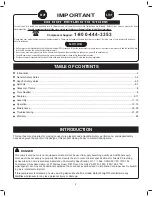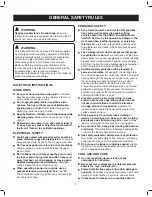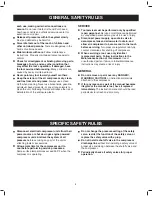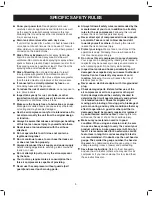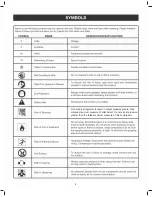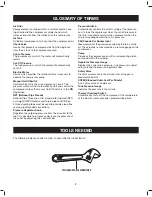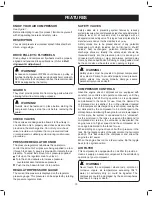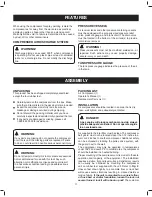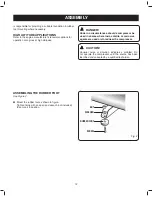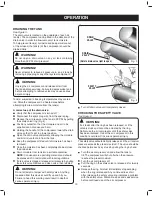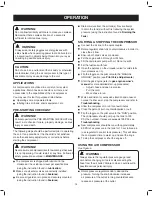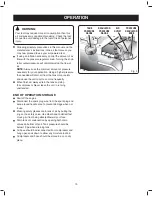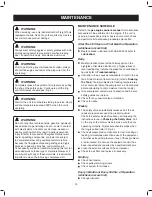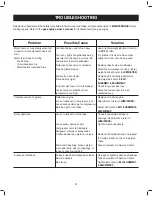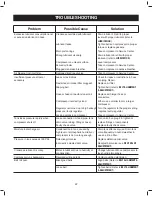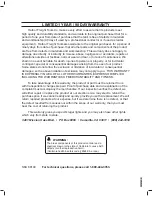
13
Turn off drain valve until completely closed.
CHECKING THE SAFETY VALVE
See Figure 4.
The safety valve will automatically release air if the air receiver
pressure exceeds the preset maximum. The valve should be
checked before each day of use by pulling the ring by hand.
Turn the air compressor on and allow the tank to
fill. The compressor will shut off when the pressure
reaches the preset maximum.
Turn the air compressor off.
Pull the ring on the safety valve to release air for twenty
seconds.
Release the ring. Air must immediately stop escaping
when the ring is released. Any continued loss of air
after releasing the safety valve ring indicates a problem
with the safety valve. Discontinue use and seek service
before continued use of the air compressor.
WARNING:
If air leaks after the ring has been released, or if the
valve is stuck and cannot be actuated by the ring,
Do Not use the air compressor until the safety valve
has been replaced. Use of the air compressor in this
condition could result in serious personal injury.
DRAINING THE TANK
See Figure 3.
The drain valve is located on the underside of each air
tank(s). The compressor can be tilted in the direction of the
drain valve in order to allow removal of tank moisture.
To help prevent tank(s) corrosion and keep moisture out
of the air used, the tank(s) of the compressor should be
drained daily.
Tank(s) subjected to freezing temperatures may contain
ice. Store the compressor in a heated area before
attempting to drain moisture from the tank(s).
A correct use of the drain valve:
Verify that the compressor is turned off.
Disconnect the spark plug wire from the spark plug.
Reduce the air pressure in the tank to 30 PSI by pulling
the safety valve ring (Fig. 4).
Position yourself so that the moisture and air to be
expelled can not cause you harm.
Holding the handle, tilt the compressor toward the drain
valve so that it’s set in a lower position.
Open the drain valve completely, allowing the moisture
and air mixture to drain from the tank.
Keep the compressor tilted until all moisture has been
removed.
Once the moisture has been completely drained, close
the drain valve.
Drain moisture from tank into a suitable container.
NOTE:
Condensate is a polluting material and should
be disposed of in compliance with local regulations.
If drain valve is clogged, release all air pressure by pulling
the safety valve. Remove and clean valve, then reinstall.
OPERATION
WARNING:
Unplug the air compressor and release all air from
the tank before servicing. Failure to depressurize tank
before attempting to remove valve may cause serious
personal injury.
WARNING:
Do not attempt to tamper with safety valve. Anything
loosened from this device could fly up and hit you.
Failure to heed this warning could result in death or
serious personal injury.
Fig. 4
Fig. 3
WARNING!
Do not open a drain valve on any air tank containing
more than 30 PSI of air pressure!
WARNING!
Never attempt to relieve air pressure in an air tank by
removing a pipe plug or any other system component!
DRAIN
VALVE
DRAIN
VALVE
SAFETY
VALVE
(Rotate drain valve right to open)


